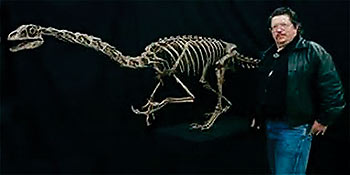Before he became the Utah State Paleontologist, Jim Kirkland cut his paleontological teeth as a student at the University of Colorado, then as a curator at the Museum of Western Colorado. I could have labelled Jim Kirkland as Utahraptor’s biggest fan. He and two colleagues (Don Burge and Robert Gaston) originally named Utahraptor in 1993 based on specimens from what is now Utahraptor State Park, discovered by Jim Jensen (Happenings March 2022). This Dinosaur Diamond find, calls out the role of Don Burge former director of the Prehistoric Museum in Price, where the original Utahraptor specimens reside, and Rob Gaston a well-known dinosaur sculptor from Fruita who has reconstructed Utahraptor skeletons for many museums including Price. The full scientific name Utahraptor ostromaysi, refers to John Ostrom a famous Yale paleontologist and raptor expert, and Chris Mays the founder of the animatronic dinosaur company Dinamation. The specimen was almost named Utahraptor spielbergi after the famous director Steven Spielberg, in the hope he would provide research funds. But that did not pan out and the honors went to two men more deeply involved in paleontology.
 |
| The Jurassic armored “ankylosaurian” dinosaur Mymooropelta, from the Mygatt-Moore quarry in western Colorado is one of several described by Utah State paleontologist Jim Kirkland. Dinosaurs from this group have been described as tanks, walking fortresses or ‘citadels’ that would have made them impregnable to predators. |
Dinosaur Jim Kirkland is probably best known among his paleontological colleagues for having named several armored dinosaurs belonging to the group generally known as ankylosaurs, and looking like spiky rubix cubes with stumpy legs and lumpy heads and tails. To begin near the beginning of his career, in 1994, Jim and paleontologist Ken Carpenter (Happenings June, 2022) described a Jurassic form known as Mymoorapelta maysi from the Morrison Formation in western Colorado. Here again, Chris Mays of the Dinamation corporation gets kudos for funding excavations and introducing animatronic dinosaurs to the Museum of Western Colorado (MWC) where Jim was curator. The dinosaur dig, the Mygatt-Moore quarry, is named after the two individuals who found the site in 1981. Since then, ~2,500 specimens have been excavated by MWC paleontologists: look for details in future Moab Happenings issues.
Jurassic armored dinosaurs like Mymoorapelta heralded even greater success of this heavily fortified group in the Cretaceous, when they became more diverse and abundant. You guessed it: Dinosaur Jim has played a central role in their study, naming three of these so called “dinosaurian tanks” (Animantarx, Cedarpelta and Gastonia) from the Cedar Mountain Formation, and a fourth from Spain. No prizes for guessing how Cedarpelta and Gastonia got their names (but just as a reminder: Moab’s Utah Friends of Paleontology group is the Gastonia chapter). Animantarx gets its named from a paleontologist’s comment that ankylosaurs were like living or animated citadels or fortresses. The epicenter, or if you prefer the citadels of Cedar Mountain dinosaur research include Utahraptor State park and various sites in nearby Dinosaur Diamond areas. These are Dino Jim Kirkland’s stomping grounds, incidentally often crossing paths trodden by that “other” Dinosaur Jim, Jim Jensen (Happenings March 2022).
 |
| Dinosaur Jim Kirkland, Utah State paleontologist stands beside a reconstructed theropod known as Falcarius. This animal was ancestor to a bizarre group of originally-carnivorous theropods, with overgrown front limb claws, that evolved herbivorous habits (Happenings October, 2021) |
You’d have to ask Jim whether he claims Utahraptor, or one of his armored citadel dinosaurs, as his favorite. He might say he loves all dinosaurs especially those from the Dinosaur Diamond (he truly does), and he might enlighten you with hours of encyclopedic conversation. He might also tell you he is happy that Utahraptor State Park has finally become a reality, thanks in part to his prolonged efforts. It is what we might call “Cretaceous Park” (Happenings August 2021) having produced more dinosaurs from the Lower Cretaceous rocks than from any other region. Jim, now a central figure in Utah paleontology, has been involved in naming at least a dozen dinosaurs, including Falcarius, an early ancestor of the bizarre herbivorous branch of the theropods. He also described new horned dinosaurs from the Grand Staircase Escalante region, beyond the Dinosaur Diamond, and has garnered media attention for such finds. He set up cooperative paleontological projects with Mexico and has used his knowledge to explain dinosaur migration patterns between North America and Asia during the Cretaceous. As often happens in paleontology, local work, in this case in the citadels of the Dinosaur Diamond, proves to have global paleontological ramifications.
|